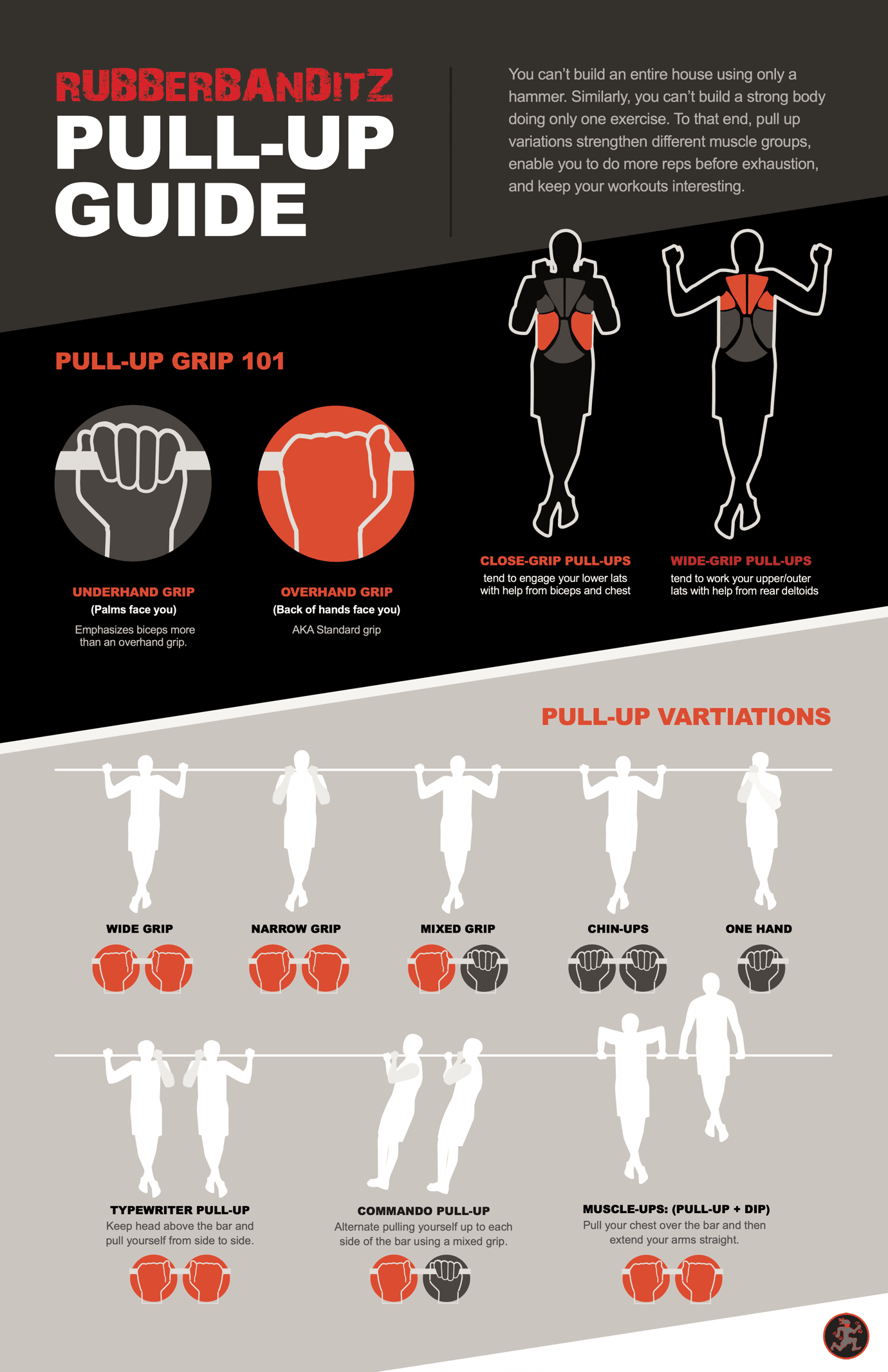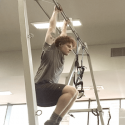You've finally conquered this chin up. Congratulations. I've seen you hit your 3 sets and they are slowly growing week by week, a couple of repetitions at a time. I'm excited for you to become that pull up beast everybody in the gym watches and wishes they were, and I want to get you there as quickly as is fair for us both. What this means now is that we need to know what muscles you are hitting, how often you should hit them (and how much they need) and how long it'll take you to recover enough to have a good session again. The easiest way to sort all this out is by looking at two lots of information:
- The muscles you are working when you do pullups and chin ups.
- Recovery science and how often that says you should train.
While the recovery science is a little different for everyone reading, the muscles we all work doing chinups are the same. Sure, some people might use their back or biceps or forearms a little more than others dependent on limb lengths etc. but for the most part, this is a lot easier to explain and get through to you all.
So what muscles do we work when we do pull ups and chin ups?
Without making it super complex, the graphic below does a good job of answering this question. In gripping the pull up bar we are using the little muscles in our hands and forearms. When you begin to pull yourself up and close the gap between the shoulders and hands, we are using the biceps and forearms (think of a bicep curl to visualise what I mean here). Finally, by bringing our elbows down towards our sides we are using the lats (latissimus dorsi), along with a little help from the rotator cuffs and teres muscle groups.

You may be asking at this point, "Why the graphic has the pecs and triceps highlighted if this is a pulling movement?" That's a fair question, and worth answering. These muscles obviously don't play a major role in the movement, but they act synergistically with the main movers to keep you stable as you perform a chin up. If you are worried about taking away training volume from these muscle groups you shouldn't be – they do not play a large enough part in the chin up to affect them for later on in the week.
Nobody can argue that pull-ups are one of the best (if not THE best) bodyweight exercises for building upper body strength. There’s a reason personal trainers worldwide include pull ups in just about every strength training regimen; it’s a primal movement that recruits muscles from all over your body to act in harmony and perform a dynamic compound movement. Compound exercises are those that engage numerous muscle groups simultaneously and build muscle strength in ways singular exercises never can. For this reason, pull-up and chin-ups have become an integral part of nearly all bodyweight training workout routines (such as calisthenics, pole fitness, powerlifting, etc) as well as more gym-intensive workouts, such as CrossFit.
Another question you're probably asking is: "chin up vs pull up"? The main differences between the two in terms of muscle activation is that chin ups (back of hands facing away with an underhand grip) use more biceps and pull ups (back of hands towards your face with an overhand grip) use more lower traps (trapezius) than chin ups, as dictated by EMG (electromyography). This means if your weight training program is already heavy on the back, chin ups are a better idea than pull ups. On the other hand, if you are smashing your biceps, spare them a little by using pull ups. (Yes, this is weird, pull ups do look like they'd use biceps more, but it is what it is. Thanks science).
Here is a helpful graphic we created to hammer home the concepts:

Wondering how to increase your pull-up reps?
It’s pretty simple. Do pull-ups. Whether it’s at your home gym using your doorway pull up bar or in the squat rack at the gym, if you want to boost your reps, it’s all about doing more pull ups.
To accelerate faster, we recommend using our assisted pullup resistance bands and training guidelines. Using a pair of bands provides you with three assistance levels, ensuring that even as you fatigue, you’re able to maintain proper form and complete your reps.
Alright- now onto the recovery science and what this says about how often you yourself should train. As I mentioned before, this is more individual and a little trickier to navigate. Before we get into this, these recommendations are general and you should experiment with what is right for you, but the idea is that whether you keep improving on your last workout or not is what tells you if you have done too much or too little. Keep that in mind. Don’t be too timid – push yourself!
Generally speaking, the back muscles can take between 15 and 30 sets per week and the biceps can recover from between 14 and 20 sets per week (assuming back has already been done at some level), and both should be trained a minimum of twice per week regardless of training status, with no more than 4 sessions per week being necessary for back and no more than 6 for biceps (says Mike Israetel of Renaissance Periodisation). You generally want to ensure that your workout routine includes 5-20 reps per set for muscle growth and long term chin up gains.
Beginners (<18months of regular training) will generally manage best with 2 or 3 days of back training (chin ups) per week with 15-20 or so sets spread across those 3 sessions. What this means is that 6 or 7 sets of direct back training per week will help you get those extra chin ups faster (generally split between two exercises- and I would recommend the other is a horizontal pulling variation like a bent over row for the sake of variety). Just ensure that your chin ups are in the 5+ zone to ensure the muscle growth you would do well to have moving forward. Following this, alter your bicep training according to the type of chin/pull up you are doing and what you can recover from in time for the next session.
Intermediate trainers (18 months to 5 years of regular training) will generally recover a little faster than beginners and should look at 3 or 4 sessions per week, with a few more sets likely being worth trying. I still recommend starting at the lower end in sets at 15-20 and would consider adding a set per exercise until you find the sweet spot in terms of recovery. At this stage, the focus is on being able to do more work at a reasonable quality. So ensure good form with minimal kipping and you will be able to slowly do more and more week to week.
Those of you who are advanced chin up specialists already (5+ years of regular training) likely already possess significant body strength. You are probably revising this article for one-arm chin ups or muscle ups or other similar moves. With this strength comes the muscle damage of stronger moves like the weighted chin ups and one arm chins. For this reason, it is more worthwhile reducing total volume and being on the lower end to ensure you are properly recovered. Let me explain this for you in a little more detail:
Option 1: You aim to continue increasing the sets and reps and stick to intermediate guidelines of three or four sessions per week. Your connective tissues start to struggle with the volume you are giving them as you perpetually increase these numbers. You expose yourself to injury risk as you aren’t fresh enough to train properly for your next session and as a result, also do not continue to improve because you are never recovered enough to train at your best. Systemic fatigue issues become more likely as your body struggles you recover.
Option 2: You train less. None of the above issues exist because you recover. You continue to improve and build muscle, albeit maybe a tad slower than you could be and may like, but hey, you are already pretty big and strong and that’s pretty ok because progress is still progress at this point.
So wrapping this all up neatly for you, when you ask: “What muscles are used when I chin up and how often should I be training these?” the answer, put briefly is this:
You are training your back and biceps, along with shoulder stabilisers and forearm muscles. The back muscles do best, on average, with 2 or 3 days worth of training in which you do 6 or 7 sets at moderate rep ranges. The biceps need more regular training, but fewer sets per day, at about 2 or 3 sets between 2 and 6 times per week depending on recovery. Beyond this, it is a matter of improving slowly in the longer term that will ensure your chin ups add reps and those muscles add size.
Happy chin ups,
Joel.





0 Comments
Leave a Comment